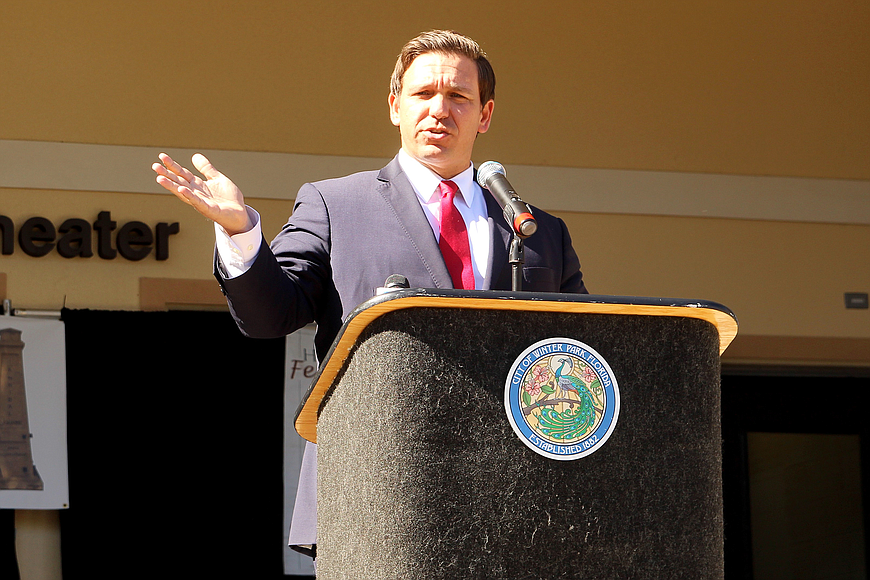During a press conference today — Thursday, June 11 — Gov. Ron DeSantis announced his recommendations to reopen Florida’s education system.
The plan, DeSantis said, is to have K-12 schools reopen in the fall at “full capacity.” Florida Commissioner of Education Richard Corcoran, who participated in the press conference, said he had the same desire to get students back to class in August.
“Working with the Department of Education (and) working with the superintendents, we have been able to provide a road map to announce the return of our schools to on-campus instructions,” DeSantis said. “And to bring long-term improvements to the instructional continuity using the federal funds provided through the CARES Act to make significant investments in our education system.”
As a part of the reopening plan, DeSantis outlined how $475 million in education-related from the Coronavirus Aid, Relief, and Economic Security (CARES) Act would be used to help Florida Schools. Overall more than $2 billion in education-related aid was provided through the CARES Act.
The $475 million, DeSantis said, would go toward a dozen different areas, including $64 million to help close achievement gaps through summer programs that are needed for students K-5 with “significant academic needs” and up to $30 million to ensure scholarships for low-income students.
RECOMMENDATIONS FOR RE-OPENING
Step-by-Step Approach: K-12 Campus Reopening Steps 1-2-3
Step 1 – June – open up campuses for youth activities and summer camps.
Step 2 – July – expand campus capacities further for summer recovery instruction.
Step 3 – August – open up campuses at full capacity for traditional start of the academic year.
Step-by-Step Approach: Postsecondary Campus Reopening
Summer A and C Semesters – state colleges, technical colleges and universities are generally virtual, with the exception of first responder and some CTE programs.
Summer B Semester – open state colleges and technical colleges for in-person summer learning. State universities continue to remain virtual as they have already decided for Summer B.
Fall Semester – open state colleges, technical colleges and universities at full capacity for traditional start of the academic year.
Reopening Strategies
- Reopening is a locally driven decision
- Education institutions should create a local safe schools plan to maintain in-person learning, which is the best method of education delivery for students.
- Create a framework for local planning by creating a Crisis Response Team.
- Establish partnerships and support in communities to make local decisions.
- Promote risk reduction through a great culture of teaching.
- Protect students, staff, and families with medical vulnerabilities.
- Recommendations to Reduce Risks at the Front Door
- Create a crisis response team at the district, school or program level, as applicable.
- Post a crisis plan and response check list where they are easily accessible.
- Consider screening students, employees and visitors through visual signage, verbal questions or visual assessments.
- As feasible and while maintaining the goal of getting students on campus every day, explore staggered schedules, start and end times to limit crowds.
- Monitor student and employee absenteeism closely, as absenteeism may be an early warning system of larger health concerns.
- Regularly update employees, parents and students with emails on best practices for at-home preventative care.
- Locally determine what constitutes an adequate prevention inventory that includes extra supplies of PPE, cloth face coverings, gloves, sanitizer, soap, etc.
- Consider creating a protocol for incoming and outgoing mail and deliveries and consider creating a “timeout” or cleansing room.
- Post signage about hygiene and social distancing in many very accessible areas.
- Conduct employee trainings for all of the above and regular employee meetings on COVID-19 updates.
- Recommendations to Redesign the School Day to Reduce Risks
- As feasible, keep groups of students together throughout the day to minimize the number of people in close contact with each person.
- As feasible, convert cafeterias, libraries, gymnasiums, auditoriums, outdoor areas into classroom space.
- Explore allowing students to eat meals in traditional classroom space or outdoors.
- Move nonessential furniture and equipment out of classrooms to increase distance between students and turn desks the same direction.
- Maintain a maximum distance between desks as possible, even if not able to achieve 6 feet, and avoid sharing of textbooks, supplies and toys.
- Consider setting up a secondary clinic in schools, exclusively for students showing symptoms of COVID-19.
- Establish procedures in consultation with school health staff to quickly separate students and staff who become sick from others.
- Create a disinfection protocol for cleaning door knobs, counters and other surfaces throughout the day.
- Consider limiting nonessential visitors to campuses and programs.
- Consider alternative meeting options for nonessential volunteer activities, clubs and other elective meetings that require in-person contact.
- Explore limiting nonessential mass gatherings or reschedule as virtual gatherings.
- Recommendations to Plan for Graduations, Sports, Band, Arts, Other Extracurriculars and Co-curriculars.
- Consult with the local department of health and the crisis response team.
- At events, consider non-contact temperature testing of adults who will be direct participants and have close contact with students.
- Monitor students who participate in extracurriculars for symptoms throughout the day.
- All equipment, instruments, uniforms, etc. should be washed or wiped down after each use.
- Explore an increased presence of law enforcement or staff at events to maintain adherence to social distancing.
- Consider limited seating at events while allowing families to sit together and marking off seating for social distancing.
- Consider having attendees arrive at events earlier, stagger exits and allow for multiple entry and exit points.
- Explore options to maintain social distancing at event facilities: public restrooms, concessions, etc.
- Consider ways to limit close contact between participants and attendees until an event concludes.
- Identify a space that can be used to isolate staff or participants if one becomes ill at an event.
- Determine what are adequate prevention supplies to have at an event for participants and attendees, including hand sanitizing stations.

